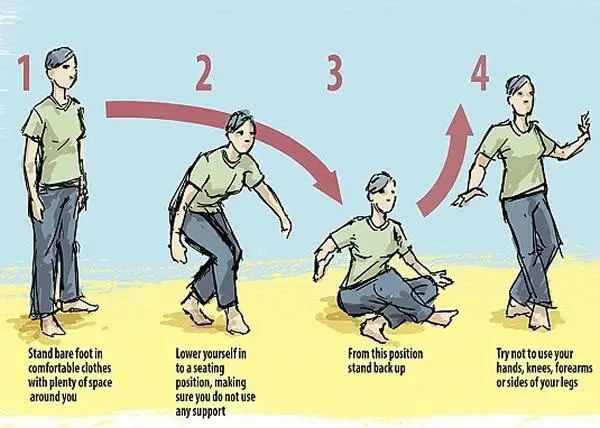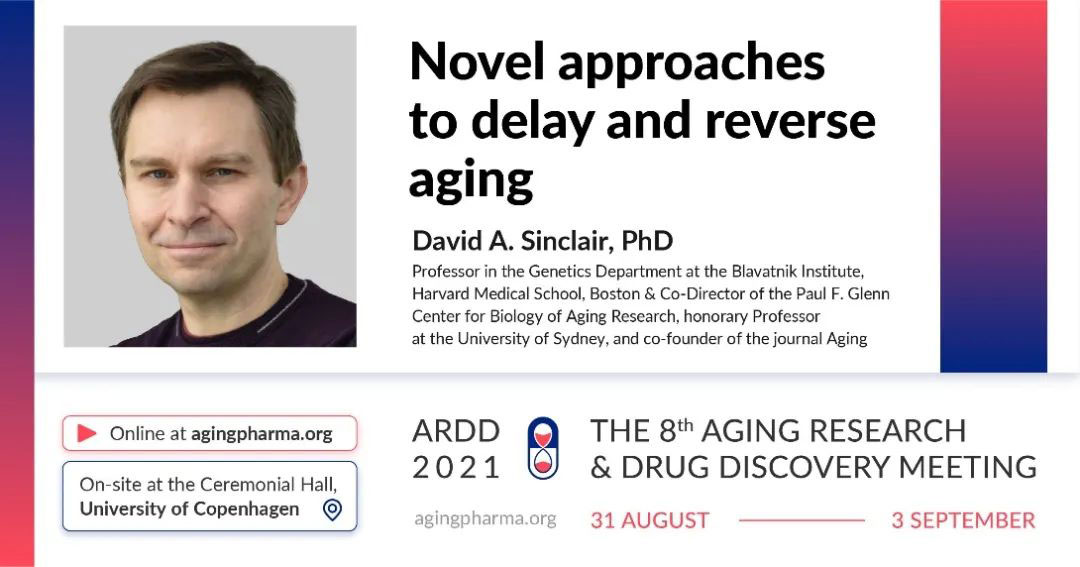
È possibile rimanere vecchi? David Sinclair, il "Padrino dell'Anti-Aging", vi aiuterà a vivere in modo scientifico e sensato fino a 100 anni o più.
Ecco due semplici test per misurare la vera età biologica:
Il primo è il test delle flessioni. Se riuscite ancora a fare più di 20 flessioni quando avete più di 45 anni, siete in ottima forma.
Un'altra serie di test è il test SRT, sviluppato da medici brasiliani. In questo test ci si siede a piedi nudi sul pavimento con le gambe incrociate e poi ci si piega rapidamente in avanti per vedere se si riesce ad alzarsi in un colpo solo.

Mentre i giovani possono farlo facilmente, le persone di mezza età devono di solito sostenersi con l'aiuto di una mano e gli anziani spesso devono mettersi in ginocchio per alzarsi.
Uno studio condotto su persone di età compresa tra i 51 e gli 80 anni ha rilevato che 157 delle 159 persone decedute entro 75 mesi non avevano ottenuto buoni risultati nel test "sit-to-stand".
Agli occhi dell'opinione pubblica, l'invecchiamento è un processo naturale e inevitabile.
1.L'invecchiamento è naturale?
Anche se diamo sempre per scontato l'invecchiamento, pensando in un'altra direzione, potrebbe essere che quando non riusciamo a spiegare qualcosa, diamo per scontato che venga "naturalmente"?
Proprio come alla fine degli anni Sessanta, quando l'uomo non riusciva a identificare la causa del cancro, per combatterlo si trattava di combatterne i sintomi, per cui tutto ciò che i medici potevano fare era asportare il maggior numero possibile di tumori e dedicare molto tempo a permettere ai pazienti di mettere ordine nella loro vita ultraterrena.
E in Longevità, David Sinclair, professore di genetica alla Harvard Medical School, esprime il suo punto di vista, ritenendo che "l'invecchiamento è una malattia, per di più curabile".
In linea di massima, quanto più frequentemente una causa compare sul certificato di morte, tanto più la società attribuisce importanza alla sua lotta.
È per questo che le malattie cardiache, il diabete di tipo 2 e la demenza sono al centro della ricerca e della medicina interventistica, mentre l'invecchiamento non lo è, pur essendo la causa principale di tutte queste malattie.
Separare l'invecchiamento dalla malattia confonde una verità sul modo in cui arriviamo alla fine della vita: è importante capire perché una persona cade da un precipizio, e ancora più importante è capire cosa l'ha portata sull'orlo del precipizio.
David Sinclair, noto come il "Padrino dell'Anti-Aging", è costantemente impegnato in ricerche e discussioni su questo tema. In uno dei suoi interventi, a cui hanno partecipato più di 400 scienziati, responsabili politici e rappresentanti dell'industria di tutto il mondo, ha esordito chiedendo: "Quante persone vogliono vivere fino a 120 anni? Ha iniziato chiedendo: "Quante persone vogliono vivere fino a 120 anni?". Un terzo del pubblico ha alzato la mano! Ha chiesto di nuovo: "Quante persone vogliono ritrovare la vitalità dei loro 20 anni?". Questa volta, tutta la sala ha alzato la mano! Subito dopo ha affermato con forza: "Studiando l'invecchiamento, è possibile non solo vivere più a lungo, ma soprattutto vivere meglio".
E, con l'entusiasmante conclusione che gli esseri umani potrebbero estendere la loro aspettativa di vita a 150 anni prima del secolo! Lo dice in base alla sua esperienza personale e ai risultati delle sue ricerche.
2.Modificare il fattore Yamanaka per "ringiovanire" i ratti
Esistono molte teorie moderne contro l'invecchiamento; si parla spesso di antiossidanti, di eliminazione dei radicali liberi e di miglioramento della funzione mitocondriale, tutti elementi che hanno l'effetto di rallentare il processo di invecchiamento.
Nel corso degli anni, con l'avanzare della ricerca, si è approfondito il livello biologico cellulare e molecolare.
Nel 2012 il professor Shinya Yamanaka dell'Università di Kyoto ha ricevuto il premio Nobel per la fisiologia medica per il suo lavoro con le cellule iPs (cellule staminali pluripotenti indotte), che sono in grado di differenziarsi in qualsiasi tipo di cellula del corpo umano, il che significa che è possibile per l'uomo creare i propri organi a partire dalle cellule iPs.
Le cellule iPs sono state indotte introducendo nelle cellule di topo quattro fattori di trascrizione chiamati fattori Yamanaka, il che significa che le cellule mature sono state riportate allo stadio di cellule staminali embrionali, "ringiovanendo" così le cellule.
Ma dobbiamo anche riconoscere il problema che le cellule adulte, sebbene possano essere perfettamente resettate dal fattore Yamanaka, perdono anche la loro impronta individuale. Dimenticano di essere cellule del sangue, del cuore o della pelle e quindi perdono le funzioni che possiedono.
L'inconveniente più importante è che la maggior parte degli animali coinvolti nello studio del fattore Yamanaka sono morti di cancro.
Per trovare un'alternativa più sicura, lo scienziato cinese Wuancheng Lu, che fa parte del team di Sinclair, ha scelto tre dei quattro fattori e li ha trasferiti in un vettore virale AAV.
Il vettore è stato progettato per fornire un fattore Yamanaka modificato alle cellule gangliari retiniche danneggiate nella parte posteriore dell'occhio di topi anziani. Dopo l'iniezione del vettore nell'occhio, i topi vengono nutriti con antibiotici per promuovere l'espressione dei geni interessati.
Sorprendentemente, i neuroni danneggiati negli occhi dei topi a cui sono state iniettate le tre cellule si sono rivitalizzati e hanno persino sviluppato nuovi assoni o si sono proiettati dagli occhi al cervello.
Da allora, il team di Sinclair ha anche invertito l'invecchiamento muscolare e cerebrale nei topi e ora sta lavorando per ringiovanire l'intero corpo dei topi anziani.
3.5 La sperimentazione clinica del precursore Super NAD+ è in corso.
In realtà, il Professor Sinclair ha trascorso gli ultimi 20 anni lavorando nel campo dell'anti-invecchiamento, cercando di invertire gli anni. E in un certo senso ci è riuscito.
In occasione della recente conferenza Aging Research and Drug Discovery (ARDD), David Sinclair, professore presso la Harvard Medical School e noto come il "padrino dell'anti-aging", ha tenuto un'affascinante conferenza sul tema "Nuovi modi per ritardare e invertire l'invecchiamento", condividendo i risultati delle sue ultime ricerche e alcuni dati inediti.

Sinclair ha iniziato il suo intervento citando la base teorica della sua ricerca sull'invecchiamento: la perdita di informazioni epigenetiche che porta all'invecchiamento e alle malattie correlate.
È quindi impegnato a rallentare o addirittura invertire l'invecchiamento puntando sui modificatori epigenetici e cita una rassegna pubblicata su Cell per riassumere le sue principali direzioni di ricerca.
Il professor Sinclair ha inoltre sottolineato l'importante impatto del NAD+ e di una sostanza precursore chiamata MIB-626.
Abbiamo scoperto che la regolazione dell'espressione di SIRT1 o l'aumento del livello di NAD+ nelle cellule rallentano la riorganizzazione dell'epigenoma e impediscono la perdita di informazioni sui modelli di espressione genica".
"Inoltre, vorrei presentare brevemente il super precursore NAD+ MIB-626, una forma policristallina di NMN, che speriamo possa trattare non solo l'invecchiamento ma anche le malattie causate dall'invecchiamento".
"Negli ultimi anni abbiamo condotto molti studi sulla sicurezza del MIB-626 e attualmente abbiamo cinque studi clinici in corso".
"Secondo alcuni dati clinici non ancora pubblicati, la somministrazione orale di 1.000 mg di sostanza al giorno per circa 1 mese ha portato a un significativo miglioramento della resistenza e a significativi miglioramenti di indicatori come i lipidi e il colesterolo."
"Abbiamo in programma di esplorare gli effetti del NAD+ negli esseri umani nei prossimi 12-24 mesi per vedere se può invertire la cecità causata da una varietà di malattie diverse negli esseri umani".
Forse sono tutti questi risultati sperimentali che hanno convinto il professor Sinclair che "anche se al momento non possiamo tornare a 20 anni, sono ottimista perché l'abbiamo fatto nei topi e non riesco a pensare a nessun motivo che ci impedisca di farlo negli esseri umani".
Da ciò si evince che il futuro della longevità è un futuro che tutti possiamo immaginare, perché è un futuro che possiamo raggiungere.

Lascia un commento